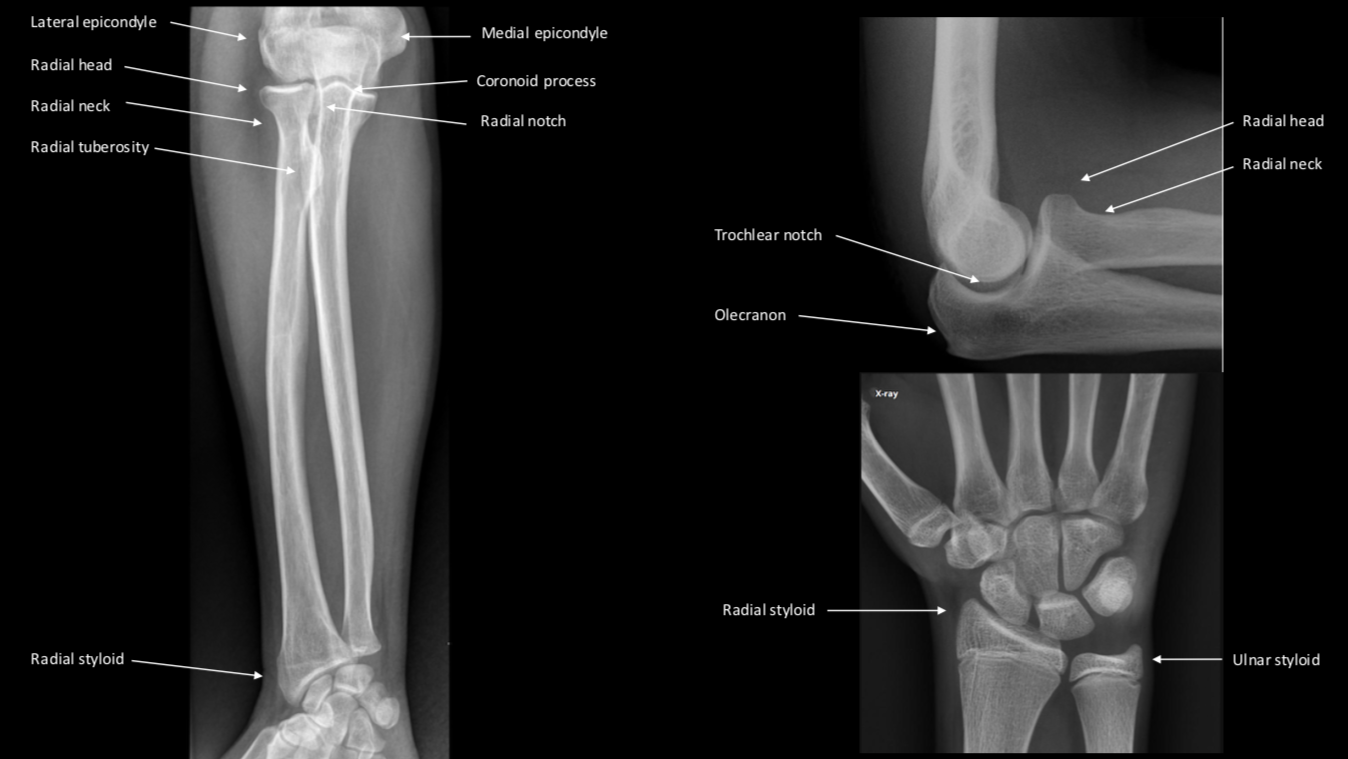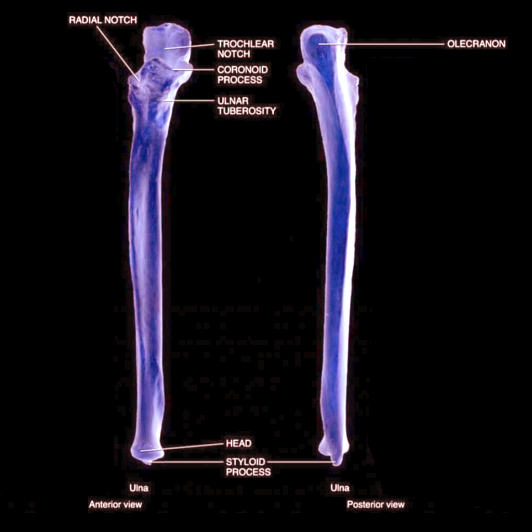[1]
Shin WJ, Kim JP, Yang HM, Lee EY, Go JH, Heo K. Topographical Anatomy of the Distal Ulna Attachment of the Radioulnar Ligament. The Journal of hand surgery. 2017 Jul:42(7):517-524. doi: 10.1016/j.jhsa.2017.03.031. Epub 2017 Apr 25
[PubMed PMID: 28450099]
[3]
Beşer CG, Demiryürek D, Özsoy H, Erçakmak B, Hayran M, Kızılay O, Özsoy A. Redefining the proximal ulna anatomy. Surgical and radiologic anatomy : SRA. 2014 Dec:36(10):1023-31. doi: 10.1007/s00276-014-1340-4. Epub 2014 Jul 17
[PubMed PMID: 25031124]
[4]
Bhandari M, Schemitsch EH. Fractures of the shaft of the ulna. Journal of orthopaedic trauma. 2004 Aug:18(7):473-5
[PubMed PMID: 15289698]
[6]
Soubeyrand M, Assabah B, Bégin M, Laemmel E, Dos Santos A, Crézé M. Pronation and supination of the hand: Anatomy and biomechanics. Hand surgery & rehabilitation. 2017 Feb:36(1):2-11. doi: 10.1016/j.hansur.2016.09.012. Epub 2016 Oct 27
[PubMed PMID: 28137437]
[7]
Lung BE, Burns B. Anatomy, Shoulder and Upper Limb, Hand Flexor Digitorum Profundus Muscle. StatPearls. 2023 Jan:():
[PubMed PMID: 30252302]
[8]
Sawyer E, Sajjad H, Tadi P. Anatomy, Shoulder and Upper Limb, Forearm Extensor Carpi Ulnaris Muscle. StatPearls. 2023 Jan:():
[PubMed PMID: 30969582]
[9]
Berezovsky DR, Bordoni B. Anatomy, Shoulder and Upper Limb, Forearm Arteries. StatPearls. 2023 Jan:():
[PubMed PMID: 31424739]
[10]
Chaudhry F, Aminullah H, Sinkler MA, Arain A. Anatomy, Shoulder and Upper Limb, Forearm Compartments. StatPearls. 2023 Jan:():
[PubMed PMID: 30969606]
[11]
Haugstvedt JR, Langer MF, Berger RA. Distal radioulnar joint: functional anatomy, including pathomechanics. The Journal of hand surgery, European volume. 2017 May:42(4):338-345. doi: 10.1177/1753193417693170. Epub 2017 Feb 1
[PubMed PMID: 28399788]
[12]
Vuillermin C, Butler L, Ezaki M, Oishi S. Ulna Growth Patterns After Soft Tissue Release With Bilobed Flap in Radial Longitudinal Deficiency. Journal of pediatric orthopedics. 2018 Apr:38(4):244-248. doi: 10.1097/BPO.0000000000000807. Epub
[PubMed PMID: 27280899]
[13]
Wiśniewski M, Baumgart M, Grzonkowska M, Szpinda M, Pawlak-Osińska K. Quantitative anatomy of the ulna's shaft primary ossification center in the human fetus. Surgical and radiologic anatomy : SRA. 2019 Apr:41(4):431-439. doi: 10.1007/s00276-018-2121-2. Epub 2018 Oct 31
[PubMed PMID: 30382328]
[14]
Koslowsky TC, Berger V, Hopf JC, Müller LP. Presentation of the vascular supply of the proximal ulna using a sequential plastination technique. Surgical and radiologic anatomy : SRA. 2015 Sep:37(7):749-55. doi: 10.1007/s00276-015-1476-x. Epub 2015 Apr 18
[PubMed PMID: 25894529]
[15]
Sheetz KK, Bishop AT, Berger RA. The arterial blood supply of the distal radius and ulna and its potential use in vascularized pedicled bone grafts. The Journal of hand surgery. 1995 Nov:20(6):902-14
[PubMed PMID: 8583061]
[16]
Gatsalov MD. [The intraorgan lymphatic bed of the periosteum in the upper extremity]. Arkhiv anatomii, gistologii i embriologii. 1967 Apr:52(4):70-7
[PubMed PMID: 6033730]
[17]
Strohl AB, Zelouf DS. Ulnar Tunnel Syndrome, Radial Tunnel Syndrome, Anterior Interosseous Nerve Syndrome, and Pronator Syndrome. The Journal of the American Academy of Orthopaedic Surgeons. 2017 Jan:25(1):e1-e10. doi: 10.5435/JAAOS-D-16-00010. Epub
[PubMed PMID: 27902538]
[18]
Franco MJ, Nguyen DC, Phillips BZ, Mackinnon SE. Intraneural Median Nerve Anatomy and Implications for Treating Mixed Median Nerve Injury in the Hand. Hand (New York, N.Y.). 2016 Dec:11(4):416-420. doi: 10.1177/1558944716643290. Epub 2016 Apr 5
[PubMed PMID: 28149207]
[21]
Siemianowicz A, Wawrzynek W, Besler K. Congenital radioulnar synostosis - case report. Polish journal of radiology. 2010 Oct:75(4):51-4
[PubMed PMID: 22802806]
Level 3 (low-level) evidence
[22]
Fulton C, Grewal R, Faber KJ, Roth J, Gan BS. Outcome analysis of ulnar shortening osteotomy for ulnar impaction syndrome. The Canadian journal of plastic surgery = Journal canadien de chirurgie plastique. 2012 Spring:20(1):e1-5
[PubMed PMID: 23598767]
[23]
Nogueira AF, Moratelli L, Martins MDS, Iupi RT, de Abreu MFM, Nakamoto JC. EVALUATION OF DISTAL FOREARM FRACTURES USING THE AO 2018 CLASSIFICATION. Acta ortopedica brasileira. 2019 Jul-Aug:27(4):220-222. doi: 10.1590/1413-785220192704218467. Epub
[PubMed PMID: 31452624]
[24]
Ali M, Clark DI, Tambe A. Nightstick Fractures, Outcomes of Operative and Non-Operative Treatment. Acta medica (Hradec Kralove). 2019:62(1):19-23. doi: 10.14712/18059694.2019.41. Epub
[PubMed PMID: 30931892]
[25]
Ring D. Monteggia fractures. The Orthopedic clinics of North America. 2013 Jan:44(1):59-66. doi: 10.1016/j.ocl.2012.08.007. Epub 2012 Oct 10
[PubMed PMID: 23174326]
[26]
Kim JK, Kim JO, Koh YD. Management of Distal Ulnar Fracture Combined with Distal Radius Fracture. The journal of hand surgery Asian-Pacific volume. 2016 Jun:21(2):155-60. doi: 10.1142/S2424835516400075. Epub
[PubMed PMID: 27454628]


